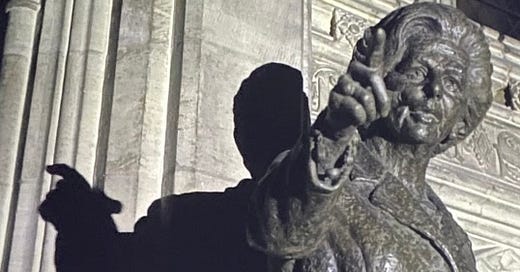The Two Faces of the Dying Monarch
On how stories of monarchy are often more effective than stories of healthy democracy
This blog contains spoilers from the outset for Marvel’s Black Panther and the first eight episodes of HBO’s House of the Dragon.
I had a really fun disagreement with my daughter on the subject of Wakanda last night. I’m one of those bores who sides with Killmonger and his regicidal mission to bring vibranium to all of the rebel contingencies fighting oppression around the world. My daughter was of the opinion that any technology that could be used for nefarious means should be kept out of the wrong hands and that the state of Wakanda seemed to have the right attitude. After all, they had the equivalent of the ‘Guns, Germs and Steel’ that Jared Diamond posited was the real explanation for how well-resourced nations subjugate other nations, often for the untapped pockets of those same resources. The very fact that Wakanda hadn’t subjugated the world with their secret technology demonstrated their suitability as custodians of that technology.
That may be the case, I countered, but Wakanda was a monarchy so the custodianship of this technology centred around archaic principles rather than democratic ones. The valid routes to controlling vibranium were decided through inheritance or through yeeting said heir over a waterfall. My daughter could have brought up Brexit and Trump as counterarguments towards democratic custodianship but she didn’t because she is a child and I am her Dad and I am always right about everything.
One point I am willing to concede is that monarchy will always trump (that word actually feels wrong in this sentence) democracy as a narrative device. There are more great narratives about the machinations of the regal court than there are about the machinations of the democratic process. Power being decided by millions of faceless voters is much less interesting than the courtly intersections between family melodrama and a good old fashioned power struggle. In this sense, The Godfather is as much a royal narrative as Shakespeare’s Richard III.
Perhaps this is a reason why I was so mesmerised by Paddy Considine’s Viserys Targareon in the first season of HBO’s Game of Thrones prequel, House of the Dragon. Throughout the season he has told the story of a seemingly weak King who turned out to be a good king — albeit in the way that a peacetime king can be seen as weak within a George RR Martin narrative.
His uneasiness with his position, as evidenced in an earlier episode where he took no joy in slaughtering a bound stag for the purposes of ceremony and symbolism, seemed to confirm the old adage that those most desiring for power are the ones who are least qualified to wield it.
However it was his final episode playing Viserys that cemented Considine’s brilliance in the role. While the loss of the odd finger here and there over the decades of his reign was enough to hide with a pair of gloves — Viserys was now bed bound with bandages or a mask covering half of his face. Despite these appendages and accoutrements (and an extra dollop of physical and digital prosthetics), the humanity of Viserys shines through. We see him drifting in a poppy-induced stupor, then rising once more to take to the iron throne to assert his will upon his feuding family and finally we see him enjoying a moment of contentment as that same family momentarily find a truce around a dining table that evening. This comes at Viserys’s insistence that the occasion goes ahead and the speech he gives after arriving at the table. Before giving the speech, Viserys removes his golden mask to reveal what is left of the right side of his face, which resembles more of a hollowed-out skull than a living human.
Many have already spoken about the symbolism of this facial dimorphism and how his non-deformed side is always facing the Targaryen side of the family and that his masked/decayed side faces the Hightower side (okay, I confess herein to lurking on twitter while remaining resolutely signed out).


Another side of the symbolism relates to how Viserys seems to be half claimed by death. This isn’t just in the sense of how half of his face resembles a decayed corpse but in how the golden mask makes him look like a statue. When a monarch dies, one part of them becomes the same desiccated corpse that we are all destined to become but they also become an icon of heraldry and mythology.
Amidst all of this symbolism, I found the episode to be one of the most moving portrayals of the isolation and loneliness felt by the dying king, his very humanity being the one detail that doesn’t fit into the grand narrative in which he plays such a pivotal ceremonial role. It was perhaps the most emotional I have got about the death of a monarch this year.
Of course, this can also happen to democratically elected leaders. In the short film, Thatcher’s Finger, by the conceptual artist Cornelia Parker, the roving shadow of the Margaret Thatcher statue in the House of Commons intimates her ideological dominance over decades of UK politics. While at the same time, the Thatcher who died to the great jubilation of my erstwhile, leftist comrades was simply a shell of the woman she had once been. Thatcher was physically dead but symbolically more powerful than she had ever been. The Parker exhibition at the Tate Britain is excellent by the way, but only runs for a few more days.
Also, you have to bet that Trump really wants to have his own statue erected after her dies. It’ll probably go up for a little while in the grounds of Mar-a-Lago before being yanked back down by his creditors. Footage of this defenestration is guaranteed to be the closing, or opening, scene of this first cinematic biopic.





